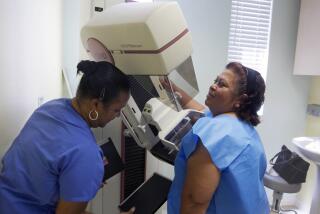This may explain why more deaths aren’t prevented by breast cancer screening
Although women have been getting mammograms for decades, the incidence of metastatic breast cancer — the kind that has already spread to another organ by the time it is found — has remained essentially unchanged since 1975. Data from the National Cancer Institute show that the rate of new cases has held steady at just under 20 per 100,000 women, despite the fact that widespread breast cancer screening programs were introduced in the 1980s.
An essay published Wednesday in the New England Journal of Medicine asks: How can this be?
The idea behind cancer screening is that it’s better to catch tumors when they are small and have not yet made patients feel sick. At this stage, presumably, a cancer is more treatable. Once it has spread to multiple sites in the body, it’s harder to wipe out — and even if you can, the treatments required to do so take a much bigger toll on the body.
If this idea is correct, then screening should result in more cancers being detected early and fewer being found after they’ve spread. And that’s exactly what has happened — with prostate cancer.
Doctors began screening men for prostate cancer in the late 1980s with a blood test that measured their level of prostate-specific antigen, or PSA. A high PSA count may be an early-warning sign of prostate cancer (although it could be caused by other medical conditions, too).
Sure enough, “the rapid uptake of PSA screening led to a dramatic spike in overall prostate cancer diagnoses during the early 1990s — one that’s unrivaled in U.S. cancer data,” according to the essay by three cancer experts.
A good number of those cancers were small and localized — and in all likelihood, many of them would have spread if they hadn’t been caught. We know this because the incidence of metastatic prostate cancer plunged from a high of about 70 cases per 100,000 men in the early 1990s to fewer than 30 cases per 100,000 about a decade later, the National Cancer Institute data show.
Another sign that prostate cancer screening saves lives through early detection is that the average age of diagnosis among men over 40 has dropped since PSA testing began. It used to be 71.8; now it’s 69.8, according to the essay.
But the same has not been true for breast cancer. Over the past 37 years, the average age of diagnosis for women over 40 has been stuck at 63.7.
There are two possible reasons for why screening mammography hasn’t made a dent in metastatic breast cancer, the cancer experts wrote.
The first is that mammograms just aren’t good enough to find metastatic breast cancers before they spread. If there were a breast cancer equivalent of PSA — a biomarker that could be found in blood — perhaps screening outcomes would be different.
A more likely explanation is that breast cancer doesn’t necessarily start in one place and then spread to others. Indeed, breast cancer researcher extraordinaire Dr. Bernard Fisher argues that by the time the cancer can be detected, it has already become a systemic disease.
If that is indeed the case, the trio wrote, a reassessment of screening mammography may be in order. If we keep expecting breast cancer to behave like prostate cancer, the result may be “screening programs that are not helpful,” they wrote. Even worse, it could lead to “administration of treatment that is either not needed or not effective.”
It’s something to be aware of during these final days of Breast Cancer Awareness Month.
The essay was written by Dr. H Gilbert Welch of the Dartmouth Institute of Health Policy and Clinical Practice in Hanover, N.H.; Dr. David Gorski of the Wayne State University School of Medicine in Detroit; and Dr. Peter C. Albertsen of the University of Connecticut Health Center in Farmington, Conn.
Follow me on Twitter @LATkarenkaplan and “like” Los Angeles Times Science & Health on Facebook.







